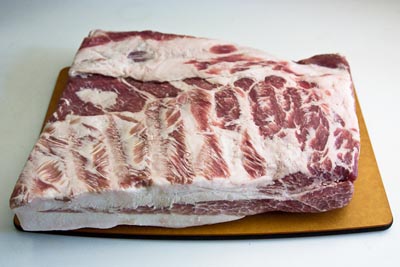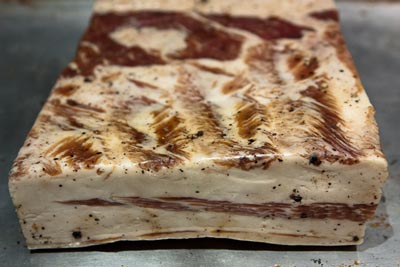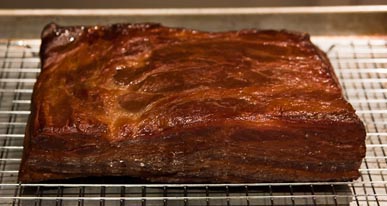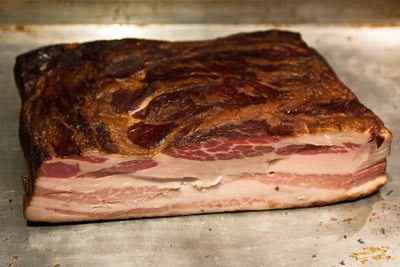It’s hard to go wrong with bacon. Even the mass-produced stuff made from the bellies of horribly treated pigs in factory farms is pretty tasty. But I’m here to tell you, there’s a better way. And it’s so incredibly delicious, I may never buy bacon from the supermarket again. For the past 8-10 days, I’ve been in the process of curing pork belly using recipes and techniques from Charcuterie: The Craft of Salting, Smoking, and Curing

I should really start with the belly. I purchased a roughly 8.5 lb pork belly from Richardson Farms, a local farm that takes pride in treating its animals humanely. Acquiring the belly was easy peasy. One weekend I stopped by the Richardson Farms booth at the Sunset Valley Farmers Market and ordered it, and then the next weekend I picked it up (they have other meat products on hand, but pork belly is sort of a specialty item). It was frozen solid when I got it, so it spent about four days in the refrigerator thawing out before I could do much with it. In that time, I set about gathering implements.
Since I had so much belly, I decided I could experiment a bit. First, I gave over not quite a pound of it to a braised pork belly recipe. (My attempt at the recipe did not turn out well, so I’m loathe to tell you whose recipe I used.) This left me with 7.5 lbs for the rest of my experimenting. Roughly half went to make bacon, and half went to make pancetta.
For the pancetta, I made a wonderfully aromatic cure of garlic, pink salt (sodium nitrite - critical to preventing botulism), kosher salt, brown sugar, black pepper, juniper berries, bay leaves, nutmeg, and thyme and smeared it all over a roughly 3 ¾ lb piece of pork belly. Then I sealed it in a zip-loc bag and smashed as much of the air out of it as I could and stowed it in the refrigerator. Every other day, I would flip the bag over and re-work in the cure for even distribution (a process called overhauling). Then after about a week (my pork belly was very thick, so I actually let it go an extra couple days), I rinsed the cure off and dried the belly thoroughly and stored it till ready to use.

If I were doing this correctly, I would have sprinkled one side of the belly with more pepper, rolled it tightly so no air pockets remained, then tied it like a roast and hung it to dry for a couple weeks. I don’t really have the set-up to accomplish the drying part of that process, so I’ve elected to leave my pancetta unrolled, unpeppered, and undried. We fried up and taste-tested some of the finished pancetta. It was subtle and sweet and wonderfully fragrant - reminiscent of bacon but definitely something more refined.
A note on pink salt (aka sodium nitrite, aka instacure #1). I could not locate this for purchase locally, and the online sources I found were going to charge about $10 for a pound of the stuff (which would likely last me years), which was fine, but then it was going to cost another $10 to ship it. I know I’m probably being stupid about this, but for some reason that annoyed me. The problem is that you really cannot skip the pink salt. It’s important for flavor, color preservation, and above all, the prevention of botulism (for those not in the know, botulism can KILL YOU). Fortunately, a friend of a friend came to the rescue and provided me with the pink salt I needed for both my pancetta and my bacon. There’s even a little bit left over for maybe one more curing project. If anyone knows of any providers of sausage-making or meat-curing supplies in or around Austin, TX, please leave a comment below or send me an email. I know there are others in the area who would like this information as well.
For the bacon, I made a very simple cure of only kosher salt, plain white sugar, and pink salt. The treatment was similar to the pancetta up to a point. The cure was worked into the belly and the whole mess was stored in a zip-loc bag for a week, again flipping and redistruting every other day. Once finished, I rinsed off the cure and thoroughly dried the bacon. Then I allowed it sit for roughly a day in the refrigerator uncovered. The idea is to leave it exposed to the air so the outside surface toughens up a bit and becomes sort of tacky. This hardened surface is called the pellicle, and it’s critical for the next step in the bacon making process - smoking.

The pellicle effectively gives the smoke something to cling to. We managed to only smoke our bacon for between 15 and 20 minutes on our regular old Weber kettle grill (using a chimney starter, we heated a bunch of coals to that glowing red stage, laid them out on one side of the grill and let them bake till they were a bit ashy on the outside, sprinkled soaked hickory chips on top of them, and plunked the bacon down on the side of the grill that wasn’t over the coals, and put the lid on to keep the smoke contained). But once the smoking was completed, the color of the bacon was indescribably beautiful, and the aroma was rich with meaty smoke. Next, we transferred the smoked belly to a baking sheet with a cooling rack set in it to finish in a 200 degree (F) oven. A probe thermometer was placed in the thickest part of the bacon. Once it hit 150 degrees (F), we moved the bacon from the oven to cool completely.

However, before it cooled, at the urging of Ruhlman and Polcyn (the authors of Charcuterie), we took a few minutes to slice off a sliver or two of the freshly “hot smoked” bacon. It was perhaps a hair too salty, but otherwise the flavor was unimaginable. Sean and I were rendered incapable of any communication more sophisticated than beatific smiles and moans of pleasure as we sampled our freshly made bacon. It, of course, had a deliciously smoky flavor. But what impressed me more was the texture of it. When I cook store-bought bacon, I fry it till it’s crackly-crisp because I can’t stand to eat the fat any other way. I find it rubbery and stringy and just generally unpleasant to eat.
But our homemade bacon wasn’t like that. The meaty part was tender and yeilded easily as it they were bitten into. The fatty part was unctuous and salty and had enough structure that you to felt yourself biting into it, but shortly thereafter, it simply melted into your tongue. The rubbery fatty yuck that comes with not-overcooked store-bought bacon was completely absent in the homemade stuff. I don’t know whether to attribute it to the beautiful pork we got from Richardson Farms or simply the process of taking it home and treating it nicely. But someone will have to answer for the fact that I may never be willing to buy bacon from a store again.
Once cooled, we stored it in the refrigerator along with our pancetta. The only sticking point I’ve found so far is that it’s so thick that I’ve been having a difficult time slicing off nice even chunks. I’m thinking of pestering the same friend of a friend who supplied the pink salt to see if he has any meat slicing tools that would work better than a very sharp 8" chefs knife. Any suggestions from the Internet at large are certainly welcome as well.